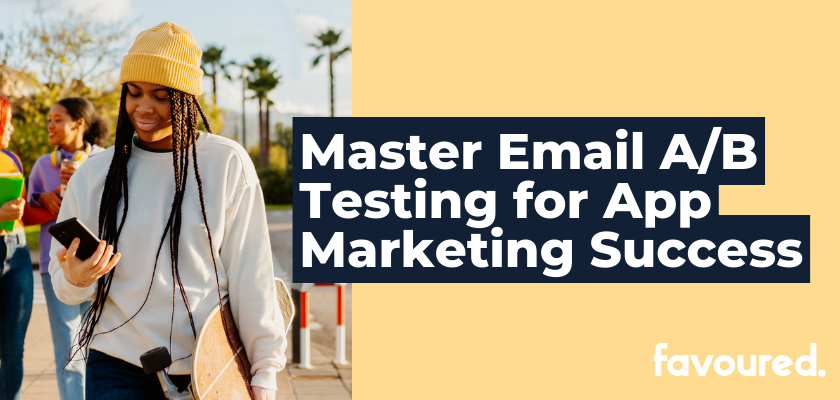
Mastering Email A/B Testing for Mobile Apps: The Ultimate Guide
Welcome to the world of email A/B testing for mobile apps!
Here at Favoured, we’re all about delivering the best results for our clients, and that includes mastering the art of email marketing. In this guide, we’ll take you through the essentials of A/B testing your email campaigns to achieve maximum success for your mobile app.
What Is Email A/B Testing?
Email A/B testing, also known as split testing, is a method used to compare two or more variations of an email campaign to determine which one performs better. The goal is to identify the version that resonates most with your target audience, ultimately leading to higher open rates, click-through rates, and overall engagement.
In the context of mobile apps, email A/B testing can be particularly valuable, as it helps you fine-tune your marketing messages to drive user acquisition, engagement, and retention.
Benefits Of Email A/B Testing
There are numerous advantages to incorporating A/B testing into your email marketing strategy for mobile apps. Some of the key benefits include:
- Improved open rates: By testing different subject lines, you can identify which ones capture your audience’s attention and entice them to open your emails.
- Increased click-through rates: Experimenting with various email elements, such as CTAs and layout, can help you determine the most effective ways to encourage recipients to take action.
- Enhanced engagement: A/B testing allows you to create more relevant and engaging content for your target audience, resulting in higher conversion rates and stronger user relationships.
- Data-driven decision making: With A/B testing, you can make informed decisions based on actual user behaviour, rather than relying on assumptions or gut feelings.
Key Metrics To Track
When conducting email A/B tests, it’s essential to track specific metrics to gauge the success of your campaigns. Some of the most critical metrics to monitor include:
- Open rate: The percentage of recipients who open your email. This metric can help you evaluate the effectiveness of your subject lines.
- Click-through rate (CTR): The percentage of recipients who click on a link within your email. A high CTR can indicate that your email content is engaging and relevant.
- Conversion rate: The percentage of recipients who take the desired action after clicking a link in your email, such as downloading your app, making a purchase, or signing up for a newsletter.
- Unsubscribe rate: The percentage of recipients who opt out of receiving future emails from you. A high unsubscribe rate may suggest that your email content is not resonating with your audience.
Understanding the basics of email A/B testing is the first step towards optimising your mobile app marketing campaigns. By grasping the concept, benefits, and key metrics of A/B testing, you’ll be well-equipped to make data-driven decisions that drive real results for your mobile app.
Setting Up Your Test
Defining Your Goal
Before you start setting up your A/B test, it’s crucial to determine the primary objective of your test. Having a clear goal will help you focus your efforts and make data-driven decisions based on the results. Your goal should align with your overall mobile app marketing strategy and be specific, measurable, attainable, relevant, and time-bound (SMART). Examples of goals for email A/B tests include:
- Increasing the open rate by 10% within 30 days
- Boosting the click-through rate by 15% within 60 days
- Reducing the unsubscribe rate by 5% within 45 days
Selecting Variables To Test
Once you’ve set your goal, it’s time to choose the variables to test in your email campaign. The variables you select should have a direct impact on your goal and be something you can measure. Here are some common email elements to consider testing:
- Subject lines: Test different wording, phrasing, or personalisation techniques to capture your audience’s attention.
- Email content: Experiment with different content styles, lengths, or structures to see what resonates with your recipients.
- Call-to-action (CTA): Try various CTA placements, wording, or button designs to encourage users to take the desired action.
- Images and visuals: Test different images, colours, or visual layouts to determine which one drives higher engagement.
- Personalisation: Compare personalised content, such as using the recipient’s name, to generic content to assess its impact on your metrics.
Creating Variations
Now that you’ve chosen your variables, it’s time to create the variations for your email campaigns. Keep the following tips in mind when crafting your variations:
- Limit the number of variations: While it may be tempting to test multiple variations, it’s best to limit yourself to two or three, so you don’t dilute your results or prolong the testing process.
- Make distinct changes: Ensure the variations are different enough to provide meaningful insights. For instance, if testing subject lines, one could be a question, while the other could be a statement.
- Keep other elements consistent: To ensure accurate results, only change the variable you’re testing and keep all other elements the same across variations.
- Consider your audience: When creating variations, take into account your target audience’s preferences and behaviours to craft relevant and engaging content.
Setting up an A/B test for your mobile app’s email campaigns is an essential step towards optimising your marketing efforts. By defining your goal, selecting the right variables to test, and creating effective variations, you’ll be well on your way to enhancing your app’s performance and building stronger relationships with your users.
Implementing & Analysing Your Test
Test Duration & Sample Size
Determining the optimal test duration and sample size is crucial for obtaining accurate and reliable results. Here are some factors to consider when deciding on these parameters:
- Test duration: The length of your test should be long enough to gather sufficient data, but not so long that it delays your marketing efforts. Generally, a test duration of 7 to 14 days is recommended for most email A/B tests.
- Sample size: Your sample size should be large enough to provide statistically significant results. Use an A/B test sample size calculator to determine the appropriate size based on your desired confidence level and the expected difference between variations.
Keep in mind that these recommendations may vary depending on your specific circumstances, such as the size of your email list or the frequency of your email campaigns.
Launching Your Test
Once you’ve determined the test duration and sample size, it’s time to launch your A/B test. Follow these steps to ensure a smooth test launch:
- Segment your email list: Divide your email list into random, equal-sized groups to ensure a fair comparison between variations.
- Send your variations: Schedule your email campaign to send the different variations to the corresponding segments of your email list.
- Monitor the progress: Keep an eye on the key metrics, such as open rates, click-through rates, and conversion rates, throughout the test duration to ensure everything is running smoothly.
Analysing Results & Drawing Conclusions
After your test has concluded, it’s essential to analyse the data, draw conclusions, and apply your findings to future email campaigns. Here’s how to go about it:
- Review the data: Examine the key metrics for each variation and compare them to determine which one performed better.
- Check for statistical significance: Use an A/B test calculator to ensure the differences between the variations are statistically significant, indicating that the results are not due to random chance.
- Draw conclusions: Based on the data, determine what you’ve learned from the test and how it can inform your future email marketing efforts. For instance, if a specific subject line format led to higher open rates, consider using a similar approach in future campaigns.
- Apply your findings: Incorporate your learnings into your email marketing strategy to continually optimise your campaigns and drive better results for your mobile app.
Implementing and analysing your email A/B tests is a critical step towards optimising your mobile app marketing campaigns. By determining the appropriate test duration and sample size, launching your test, and analysing the results, you’ll be able to make data-driven decisions that enhance your app’s performance and foster stronger relationships with your users.
Best Practices
Consistent Testing
To achieve long-term success in email marketing for mobile apps, it’s crucial to make A/B testing a consistent part of your strategy. Regular testing allows you to:
- Continuously optimise your campaigns: Stay ahead of the curve by continually refining your email campaigns based on data-driven insights.
- Adapt to changing trends: Keep your email marketing efforts relevant and up-to-date by adapting to evolving user preferences, industry trends, and market dynamics.
- Validate new ideas: Use A/B testing to validate new marketing concepts or tactics before fully implementing them in your campaigns.
Avoiding Common Pitfalls
As with any marketing endeavour, there are potential pitfalls to watch out for when conducting email A/B tests. Here are some common mistakes and how to avoid them:
- Testing too many variables at once: Focus on testing one variable at a time to ensure accurate results and avoid confusion when analysing the data.
- Ignoring statistical significance: Make sure your test results are statistically significant to avoid drawing conclusions based on random chance or insufficient data.
- Focusing solely on short-term gains: While it’s essential to optimise for immediate results, also consider the long-term impact of your email marketing strategy on user retention and lifetime value.
Utilising Automation & Growth Hacking Strategies
Leveraging automation and growth hacking techniques can help streamline your email A/B testing efforts and drive even better results for your mobile app. Consider the following strategies:
- Email automation: Use email marketing automation tools to schedule and send your A/B tests, track key metrics, and segment your email list efficiently.
- Dynamic content: Implement dynamic content in your email campaigns to personalise messages based on user behaviour, preferences, or demographics, and A/B test the effectiveness of various personalisation techniques.
- Multivariate testing: Once you’re comfortable with A/B testing, consider using multivariate testing to assess the impact of multiple variables simultaneously and identify the best combination of elements for your campaigns.
Mastering email A/B testing for your mobile app is an ongoing process that requires consistent effort, learning, and adaptation. By following best practices, avoiding common pitfalls, and utilising automation and growth hacking strategies, you’ll be well on your way to achieving long-term success in your email marketing campaigns.
As a data-driven full-funnel marketing agency, Favoured believes in the power of optimising every aspect of the customer journey, and that includes email marketing.
We’re dedicated to helping businesses drive real results, and A/B testing plays a crucial role in this process. Reach out if you want to supercharge your email campaigns with us. Happy testing!





















